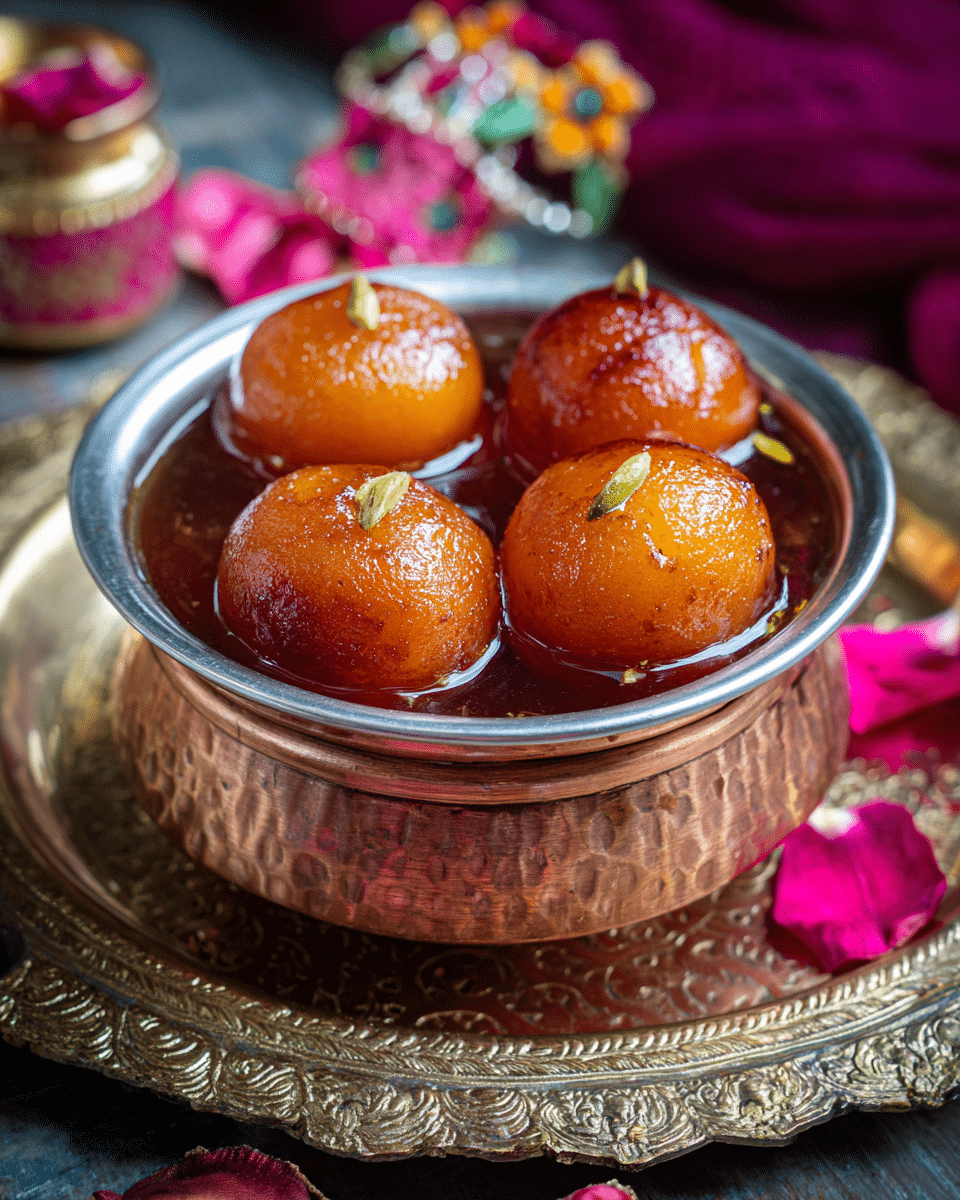Gulab Jamun is a beloved Indian dessert known for its rich, sweet flavor and soft, melt-in-the-mouth texture. These golden brown dumplings are made from milk solids, deep-fried, and soaked in fragrant rose and cardamom-infused sugar syrup, making them a staple at festive occasions and celebrations.
FULL RECIPE
Ingredients
1.For the Jamun Dough:
- 1 cup milk powder
- ¼ cup all-purpose flour
- ½ teaspoon baking soda
- 2 tablespoons ghee (clarified butter)
- 2–3 tablespoons milk (adjust as needed for dough consistency)
- 1 teaspoon lemon juice (optional, helps soften texture)
2.For the Sugar Syrup:
- 1½ cups sugar
- 1½ cups water
- 3–4 green cardamom pods, slightly crushed
- 1 teaspoon rose water (optional but traditional)
- A few strands of saffron (optional)
3.For Frying:
- Ghee or oil, for deep frying
Directions
- In a mixing bowl, combine milk powder, all-purpose flour, and baking soda. Mix well to ensure even distribution of the dry ingredients.
- Add ghee and begin mixing using your fingers until the mixture resembles coarse crumbs. Gradually add milk, starting with 2 tablespoons, kneading gently to form a soft, smooth, slightly sticky dough. Add lemon juice if desired to keep the balls soft after frying.
- Cover the dough and let it rest for 10 minutes. Meanwhile, start preparing the sugar syrup by combining sugar, water, cardamom pods, and saffron in a pan. Bring to a boil, then reduce heat and simmer for 8–10 minutes until slightly sticky. Add rose water at the end and turn off the heat. Keep warm.
- Divide the rested dough into small portions and gently roll into smooth, crack-free balls using greased hands. Do not apply too much pressure; the texture should be airy and soft.
- Heat ghee or oil over medium-low heat in a deep pan. Once hot, gently slide in the dough balls, a few at a time. Fry on low to medium heat, stirring continuously for even coloring. Fry until they turn golden brown, about 7–8 minutes.
- Remove fried jamuns with a slotted spoon and immediately transfer them into the warm sugar syrup. Let them soak for at least 1–2 hours. The longer they soak, the softer and juicier they become.
- Serve warm or at room temperature, garnished with chopped pistachios or almonds if desired.
Nutrition Facts
- Calories: 220
- Total Fat: 9g
- Saturated Fat: 5g
- Cholesterol: 20mg
- Sodium: 60mg
- Total Carbohydrates: 32g
- Dietary Fiber: 0g
- Sugars: 28g
- Protein: 3g
- Calcium: 8% DV
- Iron: 2% DV
Cultural Significance of Gulab Jamun
Gulab Jamun holds a cherished place in Indian culture and culinary traditions. Often served during festivals, weddings, and special celebrations, it symbolizes sweetness and joy. This dessert has roots in Mughal cuisine and has evolved into various regional adaptations across the Indian subcontinent. It is commonly offered as a gesture of hospitality and is considered an auspicious treat during religious occasions, making it more than just a dessert but a cultural emblem.
Texture and Flavor Profile
One of the defining features of Gulab Jamun is its soft, spongy texture that almost melts in your mouth, combined with the rich, sweet flavor from the sugar syrup infused with rose water and cardamom. The syrup not only sweetens the fried dough balls but also keeps them juicy and tender. The slight hint of rose and the warm aroma of cardamom elevate the dessert to a fragrant, indulgent experience.
Health Considerations
While Gulab Jamun is undeniably delicious, it is also calorie-dense and high in sugar and fat due to the frying and syrup soaking process. It should be enjoyed in moderation, especially for individuals managing diabetes or those following low-fat or low-sugar diets. However, the use of milk powder offers some protein content, and cardamom is known for its digestive properties. For a healthier twist, some variations use baked or air-fried methods to reduce oil content.
Variations Across Regions
Different regions have put their own spin on Gulab Jamun, leading to exciting variations. In Bengal, for example, the dessert is called “Pantua,” made with chhena (Indian cottage cheese) for a slightly different texture. Some recipes incorporate saffron in the dough for a richer flavor and golden hue. Modern adaptations include stuffed Gulab Jamun filled with nuts or dried fruits, adding an unexpected crunch and burst of flavor inside the soft ball.
Serving Suggestions
Gulab Jamun is typically served warm or at room temperature, often garnished with crushed pistachios, almonds, or silver leaf (varak) for an elegant presentation. It pairs beautifully with a scoop of vanilla or cardamom-flavored ice cream, which balances the syrup’s sweetness with creaminess and cold contrast. For festive occasions, it can also be served alongside other Indian sweets or with chai tea to enhance the overall experience.
Storage and Shelf Life
Due to its syrup-soaked nature, Gulab Jamun stays moist and fresh for a couple of days when stored in an airtight container in the refrigerator. It is best consumed within 2-3 days for optimal texture and flavor. Reheating gently in the microwave or steaming before serving can help restore the softness. Avoid freezing as it can alter the texture and make the balls hard once thawed.
Common Mistakes and Troubleshooting
Making perfect Gulab Jamun requires careful attention to dough consistency and frying temperature. Too hard a dough results in dense, chewy balls, while overly wet dough can break apart during frying. Frying at too high a temperature causes uneven browning and soggy insides, while too low heat makes them absorb excess oil. The syrup must be warm but not boiling when soaking to prevent disintegration of the jamuns. Knowing these nuances helps achieve soft, juicy results.
Nutritional Enhancements and Substitutions
To make Gulab Jamun slightly more nutritious, some recipes suggest substituting part of the all-purpose flour with whole wheat flour or incorporating powdered nuts into the dough for added protein and texture. Using low-fat milk powder or ghee alternatives can reduce saturated fat content. Additionally, natural sweeteners like jaggery syrup can replace refined sugar syrup for a more wholesome version with a subtle caramel flavor.
Pairing Gulab Jamun with Other Dishes
Gulab Jamun’s sweetness and syrupy richness complement spicy and savory Indian dishes well. It provides a perfect finish to meals heavy on spices like biryanis, curries, or kebabs. The dessert also goes well with drinks like masala chai, cardamom coffee, or sweet lassi, which help balance the richness and cleanse the palate between bites, enhancing the overall dining experience.
Modern Twists and Fusion Ideas
Contemporary chefs and home cooks have experimented with Gulab Jamun beyond its traditional form. Fusion recipes include Gulab Jamun cheesecake, cupcakes with Gulab Jamun filling, and even savory versions incorporating cheese or herbs. These innovative adaptations show the versatility of the classic dessert and how it continues to inspire culinary creativity worldwide.
Conclusion
Gulab Jamun remains a timeless dessert that beautifully combines tradition, flavor, and cultural significance. Its soft texture and fragrant syrup make it a favorite indulgence during celebrations and everyday treats alike. Whether enjoyed in its classic form or through inventive variations, Gulab Jamun continues to captivate dessert lovers around the world, offering a sweet taste of Indian heritage with every bite.






